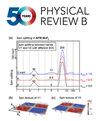轨道分裂在二维Janus过渡金属二硫化物中的关键作用:从稳定性到铁谷材料设计
IF 3.7
2区 物理与天体物理
Q1 Physics and Astronomy
引用次数: 0
摘要
Janus过渡金属二硫化物(JTMD)单层膜拓宽了二维(2D)材料的家族。尽管有许多关于jtmd的理论预测,但其在电子尺度上的潜在稳定性机制仍未得到系统的探索。在这里,我们研究了h相jtmd的基团依赖稳定性,揭示了它的起源是键模式竞争,以及通过𝑑-orbitals排斥在费米能级上的反键轨道分裂。确定了三种轨道分裂构型来解释基团依赖的稳定性和结构相偏好。在稳定性的电子起源的指导下,我们设计了一类具有本征铁谷性质的稳定的二维Janus过渡金属卤化物。这项工作弥合了稳定性预测和电子结构之间的差距,并扩展了合成二维Janus材料的设计指南。本文章由计算机程序翻译,如有差异,请以英文原文为准。
Key role of orbital splitting in two-dimensional Janus transition metal dichalcogenides: From stability to ferrovalley material design
Janus transition metal dichalcogenide (JTMD) monolayers have broadened the family of two-dimensional (2D) materials. Despite numerous theoretical predictions of JTMDs, the underlying stability mechanisms at the electronic scale remain systematically underexplored. Here, we investigate the group-dependent stability of 1H-phase JTMDs, revealing its origin in the bonding mode competition, coupled with the antibonding orbital splitting at the Fermi level through 𝑑-orbitals repulsion. Three orbital splitting configurations are identified to explain the group-dependent stability and structural phase preferences. Guided by the electronic origin of stability, we design a family of stable 2D Janus transition metal halides with intrinsic ferrovalley properties. This work bridges the gap between stability predictions and electronic structures, and extends the design guidelines for synthesizing 2D Janus materials.
求助全文
通过发布文献求助,成功后即可免费获取论文全文。
去求助
来源期刊

Physical Review B
物理-物理:凝聚态物理
CiteScore
6.70
自引率
32.40%
发文量
0
审稿时长
3.0 months
期刊介绍:
Physical Review B (PRB) is the world’s largest dedicated physics journal, publishing approximately 100 new, high-quality papers each week. The most highly cited journal in condensed matter physics, PRB provides outstanding depth and breadth of coverage, combined with unrivaled context and background for ongoing research by scientists worldwide.
PRB covers the full range of condensed matter, materials physics, and related subfields, including:
-Structure and phase transitions
-Ferroelectrics and multiferroics
-Disordered systems and alloys
-Magnetism
-Superconductivity
-Electronic structure, photonics, and metamaterials
-Semiconductors and mesoscopic systems
-Surfaces, nanoscience, and two-dimensional materials
-Topological states of matter
 求助内容:
求助内容: 应助结果提醒方式:
应助结果提醒方式:


